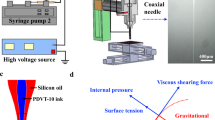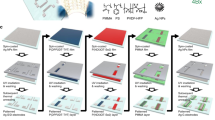Abstract
The fabrication of organized molecular-scale structures is key to realizing high-performance molecular- and conjugated-polymer devices. Here, we demonstrate a unique single-molecular processing technique using electrochemistry, termed 'electrochemical epitaxial polymerization'. This technique is based on step-by-step electropolymerization of the monomer by applying voltage pulses to a monomer–electrolyte solution that also contains iodine. Using this technique, we observe the formation of high-density arrays of single conjugated-polymer wires as long as 75 nm on the surface of a Au(111) electrode. Our findings unveil the mechanism of electropolymerization, showing that the conjugated polymer wires grow from nuclei adsorbed on the iodine-covered Au(111) surface. The results may also open the door to mass-production of molecular-scale devices based on conjugated polymers.
This is a preview of subscription content, access via your institution
Access options
Subscribe to this journal
Receive 12 print issues and online access
$259.00 per year
only $21.58 per issue
Buy this article
- Purchase on Springer Link
- Instant access to full article PDF
Prices may be subject to local taxes which are calculated during checkout







Similar content being viewed by others
References
Sirringhaus, H. et al. Two-dimensional charge transport in self-organized, high-mobility conjugated polymers. Nature 401, 685–688 (1999).
Dimitrakopoulos, C.D. & Mascaro, D.J. Organic thin-film transistors: a review of recent advances. IBM J. Res. Dev. 45, 11–27 (2001).
Friend, R.H. et al. Electroluminescence in conjugated polymers. Nature 397, 121–128 (1999).
Gross, M. et al. Improving the performance of doped π-conjugated polymers for use in organic light-emitting diodes. Nature 405, 661–665 (2000).
Yu, G., Gao, J., Hummelen, J.C., Wudl, F. & Heeger, A.J. Polymer photovoltaic cells: enhanced efficiencies via a network of internal donor-acceptor heterojunctions. Science 270, 1789–1791 (1995).
Granström, M. et al. Laminated fabrication of polymeric photovoltaic diodes. Nature 395, 257–260 (1998).
Tourillon, G. & Garnier, F. New electrochemically generated organic conducting polymers. J. Electroanal. Chem. 135, 173–178 (1982).
Garnier, F., Tourillon, G., Barraud, J.Y. & Dexpert, H. First evidence of crystalline structure in conducting polythiophene. J. Mater. Sci. 20, 2687–2694 (1985).
Nyffenegger, R.M. & Penner, R.M. Nanometer-scale electropolymerization of aniline using the scanning tunneling microscope. J. Phys. Chem. 100, 17041–17049 (1996).
Kolb, D.M., Ullmann, R. & Will, T. Nanofabrication of small copper clusters on gold(111) electrodes by a scanning tunneling microscope. Science 275, 1097–1099 (1997).
Zhou, L., Ho, P.K.H., Zhang, P.C., Li, S.F.Y. & Xu, G.Q. In situ STM tip-induced electropolymerization of poly(3-octylthiophene). Appl. Phys. A 66, S643–S647 (1998).
Maynor, B.W., Filocamo, S.F., Grinstaff, M.W. & Liu, J. Direct-writing of polymer nanostructures: poly(thiophene) nanowires on semiconducting and insulating surfaces. J. Am. Chem. Soc. 124, 522–523 (2002).
Iyoda, T. et al. The 100-Å-order depth profile control of polypyrrole-poly(3-methylthiophene) composite thin film by potential-programmed electropolymerization. J. Phys. Chem. 95, 5215–5220 (1991).
Favier, F., Walter, E.C., Zach, M.P., Benter, T. & Penner, R.M. Hydrogen sensors and switches from electrodeposited palladium mesowire arrays. Science 293, 2227–2231 (2001).
Favier, F., Liu, H. & Penner, R.M. Size-selective growth of nanoscale tetrathiafulvalene bromide crystallites on platinum particles. Adv. Mater. 13, 1567–1570 (2001).
Okawa, Y. & Aono, M. Nanoscale control of chain polymerization. Nature 409, 683–684 (2001).
Okawa, Y. & Aono, M. Linear chain polymerization initiated by a scanning tunneling microscope tip at designated positions. J. Chem. Phys. 115, 2317–2322 (2001).
Lin, L.G. et al. An in situ STM study on the long-range surface restructuring of Au(111) in a non-chloroaluminumated ionic liquid. Electrochem. Commun. 5, 995–999 (2003).
Huang, L., Zeppenfeld, P., Horch, S. & Comsa, G. Determination of iodine adlayer structures on Au(111) by scanning tunneling microscopy. J. Chem. Phys. 107, 585–591 (1997).
Kunitake, M., Batina, N. & Itaya, K. Self-organized porphyrin array on iodine-modified Au(111) in electrolyte solutions: in situ scanning tunneling microscopy study. Langmuir 11, 2337–2340 (1995).
Samorí, P., Severin, N., Müllen, K. & Rabe, J.P. Macromolecular fractionation of rod-like polymers at atomically flat solid-liquid interfaces. Adv. Mater. 12, 579–582 (2000).
Mena-Osteritz, E. et al. Two-dimensional crystals of poly(3-alkyl-thiophene)s: direct visualization of polymer folds in submolecular resolution. Angew. Chem. Int. Edn 39, 2680–2684 (2000).
Grévin, B., Rannou, P., Payerne, R., Pron, A. & Travers, J.P. Scanning tunneling microscopy investigations of self-organized poly(3-hexylthiophene) two-dimensional polycrystals. Adv. Mater. 15, 881–884 (2003).
Grévin, B., Rannou, P., Payerne, R., Pron, A. & Travers, J.P. Multi-scale scanning tunneling microscopy imaging of self-organized regioregular poly(3-hexylthiophene) films. J. Chem. Phys. 118, 7097–7102 (2003).
Charra, F., Fichou, D., Nunzi, J.M. & Pfeffer, N. Picosecond photoinduced dichroism in solutions of thiophene oligomers. Chem. Phys. Lett. 192, 566–570 (1992).
Tao, N.J. & Lindsay, S.M. In situ scanning tunneling microscopy study of iodine and bromine adsorption on Au(111) under potential control. J. Phys. Chem. 96, 5213–5217 (1992).
Yamada, T., Batina, N. & Itaya, K. Structure of electrochemically deposited iodine adlayer on Au(111) studied by ultrahigh-vacuum instrumentation and in situ STM. J. Phys. Chem. 99, 8817–8823 (1995).
Roncali, J. Conjugated poly(thiophenes): synthesis, functionalization, and applications. Chem. Rev. 92, 711–738 (1992).
Langeveld-Voss, B.M.W. et al. Circular dichroism and circular polarization of photoluminescence of highly ordered poly{3,4-di[(S)-2-methylbutoxy]thiophene}. J. Am. Chem. Soc. 118, 4908–4909 (1996).
Langeveld-Voss, B.M.W., Janssen, R.A.J. & Meijer, E.W. On the origin of optical activity in polythiophenes. J. Molec. Struct. 521, 285–301 (2000).
Donhauser, Z.J. et al. Conductance switching in single molecules through conformational changes. Science 292, 2303–2307 (2001).
Ramachandran, G.K. et al. A bond-fluctuation mechanism for stochastic switching in wired molecules. Science 300, 1413–1416 (2003).
Furukawa, Y. Electronic absorption and vibrational spectroscopies of conjugated conducting polymers. J. Phys. Chem. 100, 15644–15653 (1996).
Daoust, G. & Leclerc, M. Structure-property relationships in alkoxy-substituted polythiophenes. Macromolecules 24, 455–459 (1991).
Leclerc, M. Optical and electrochemical transducers based on functionalized conjugated polymers. Adv. Mater. 11, 1491–1498 (1999).
Welsh, D.M. et al. Regiosymmetric dibutyl-substituted poly(3,4-propylenedioxythiophene)s as highly electron-rich electroactive and luminescent polymers. Macromolecules 35, 6517–6525 (2002).
Acknowledgements
This work was financially supported by Research Foundation of the Tokyo Electric Power Company, Japan Society for the Promotion of Science, and Support Center for Advanced Telecommunications Technology Research.
Author information
Authors and Affiliations
Corresponding author
Ethics declarations
Competing interests
The authors declare no competing financial interests.
Rights and permissions
About this article
Cite this article
Sakaguchi, H., Matsumura, H. & Gong, H. Electrochemical epitaxial polymerization of single-molecular wires. Nature Mater 3, 551–557 (2004). https://doi.org/10.1038/nmat1176
Received:
Accepted:
Published:
Issue Date:
DOI: https://doi.org/10.1038/nmat1176
This article is cited by
-
Controlled assemblies of conjugated polymers in metal−organic frameworks
Polymer Journal (2022)
-
Covalent on-surface polymerization
Nature Chemistry (2020)
-
Ultra-high resolution imaging of thin films and single strands of polythiophene using atomic force microscopy
Nature Communications (2019)
-
Templateless synthesis of polypyrrole nanowires by non-static solution-surface electropolymerization
Journal of Solid State Electrochemistry (2016)
-
Ultrathin inorganic molecular nanowire based on polyoxometalates
Nature Communications (2015)



